Welcome
to the McGill Bird Observatory weekly report.
Click here for a complete listing of our archives.
Comments or
questions are welcome at "mbo AT migrationresearch.org".
|
PICTURE
OF THE WEEK: |
|
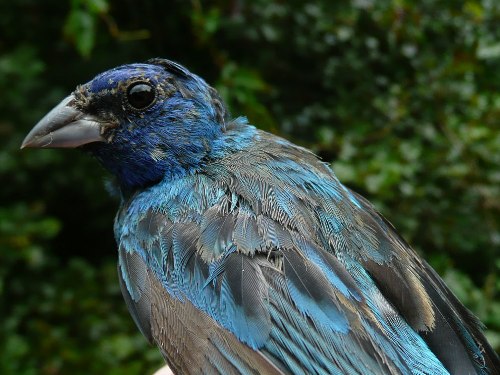
In the early part of our Fall Migration Monitoring Program, many of MBO's local breeders
(and some migrants from farther north) are undergoing their annual moult, and like this
second-year male Indigo Bunting, are looking quite a bit scruffier than usual.
(Photo by Gay Gruner)
-
|
|
|
THIS WEEK |
THIS FALL |
2012 TOTAL |
SITE TOTAL |
|
# birds (and species) banded |
281 (34) |
281 (34) |
1546 (71) |
37297 (108) |
|
# birds (and species) repeat |
50 (13) |
50 (13) |
388 (38) |
6801 (69) |
|
# birds (and species) return |
13 (10) |
13 (10) |
152 (22) |
1113 (38) |
|
# species observed |
74 |
74 |
147 |
207 |
|
# net hours |
560.0 |
560.0 |
3819.8 |
62918.9 |
|
# birds banded / 100 net hours |
50.2 |
50.2 |
40.5 |
59.3 |
|
|
Note: table does not include nocturnal banding (owls) |
|
Banders-in-charge: Simon Duval, Gay Gruner
Assistants: Nicolas Bernier, Sue Bishop, Jean Demers, Leah den Besten, Rui de Jesus, Barbara Frei, Louise Gagné, Tiffany Gilchrist, Monique Groulx, Alison Hackney, Myriam Haineault, Lima Kayello, Lisa Keelty, Shelly Kirk, Lance Laviolette, Barbara MacDuff, Ahmad Shah, Clémence Soulard, Rodger Titman, Monique Venne
Notes: Once again, although it still feels very much like summer, our Fall Migration Monitoring Program kicked off on August 1, and the results as usual show that the birds know fall is on the way despite the weather. For a third consecutive year, we set a new record for the number of birds banded in our first week of fall, jumping from 250 in 2010 to 257 in 2011, and now up to 281 in 2012. We also had a record-tying 50 repeats and record-setting 13 returns this week ... no easing into the season for our banders and assistants! As is often the case, our first day was especially busy, with 80 birds banded on August 1 alone. Naturally some of these early season birds are local breeders and their offspring, but the numbers alone are proof that many of these birds are migrants passing through MBO, and the 74 species observed this week (just one shy of a week 1 record) also provides strong evidence of the influx of birds compared to the more modest diversity of breeding birds typically present in June and July.
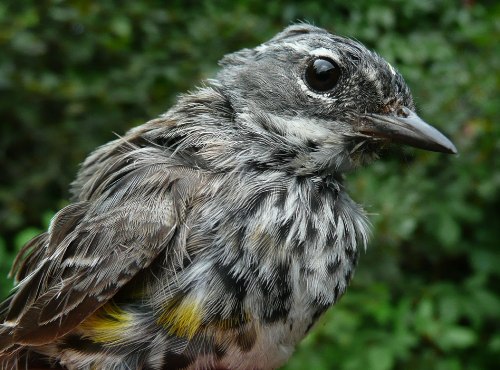
Another moulting adult banded during the first week of the season was this Yellow-rumped Warbler - more of a surprise as the species does not breed at MBO
(Photo by
Gay Gruner) |
Naturally all 34 species we banded this week were new for the fall, but White-breasted Nuthatch was also a first for 2012. Among species observed, Common Tern, Black Tern, and Purple Martin were new additions for 2012 - and the terns are always a rare sight at MBO, so spotting both species within the same week was quite a treat. Two of the species we recorded as returns were also firsts for 2012 - Nashville Warbler and Rose-breasted Grosbeak. The Nashville Warbler is particularly interesting, as it is the first of our confirmed moult migrants to return this fall. We banded this individual on August 4, 2011, and recaptured it three more times over the following month as it completed its moult before continuing its migration. This year we recaptured it on August 6, and will perhaps again get an opportunity to document how long it hangs around.
|
This week’s top 10
[last year's rank for this week in brackets]
|
# individuals banded |
mean # individuals observed daily |
|
1. Song Sparrow (55) [2] |
1. American Crow (21)
[8] |
|
2. Yellow Warbler (31) [1] |
2. American Goldfinch (21) [7] |
|
3. Common Yellowthroat (28)
[8] |
3. Cedar Waxwing (20)
[2] |
|
4. American Redstart (23)
[3] |
4. American Robin (18)
[5] |
|
5. Red-eyed Vireo (13) [-] |
5. Black-capped Chickadee (16)
[4] |
|
5. Cedar Waxwing (13) [4] |
6. Song Sparrow (13) [9] |
|
7. White-throated Sparrow (11)
[-] |
7. Red-winged Blackbird (13)
[1] |
|
8. Black-capped Chickadee (10) [6] |
8. Yellow Warbler (11) [3] |
|
8. Gray Catbird (10)
[-] |
9. Common Yellowthroat (10) [-] |
|
10. Baltimore Oriole (8) [8]
|
10. Common Grackle (7)
[6] |
|
As in all previous years, Song Sparrow and Yellow Warbler occupied the top two spots on the banding list for the first week of fall, a remarkably consistent pattern. This year, Song Sparrow returned to the top spot, after slipping behind Yellow Warbler for three of the past four years. The 55 Song Sparrows banded this week nearly matched the record start to the season in 2007 when we had 57. Common Yellowthroat was a surprising entry in third place, with 28 individuals banded; previously this species had never ranked higher than 8th in the first week of fall, and the peak count was 11 individuals. Similarly, the 23 American Redstarts banded this week is a record count for so early in fall, although just by one. Red-eyed Vireo is also off to an unusually good start, having appeared in the top ten for week 1 only twice in the previous 7 years. Rounding out the top ten were fairly typical numbers of several of our local breeders - Cedar Waxwing, White-throated Sparrow, Black-capped Chickadee, Gray Catbird, and Baltimore Oriole. Species that made the top ten last year but not this year were American Robin, Nashville Warbler, and Black-throated Blue Warbler.
Whereas we have seen great consistency over the years with the species topping the banding list in the first week of fall, the same is not true for the species observed during the same period. Five different species have taken top spot over the past seven years (Cedar Waxwing, Song Sparrow, Common Grackle, Red-winged Blackbird [3 times], and American Goldfinch), and this year American Crow gets added to that list. All of the previous "champions" also were among the top ten this year, in addition to American Robin, Black-capped Chickadee, Yellow Warbler, and Common Yellowthroat. Only Common Yellowthroat was added to the list compared to last year's version, displacing Red-eyed Vireo.
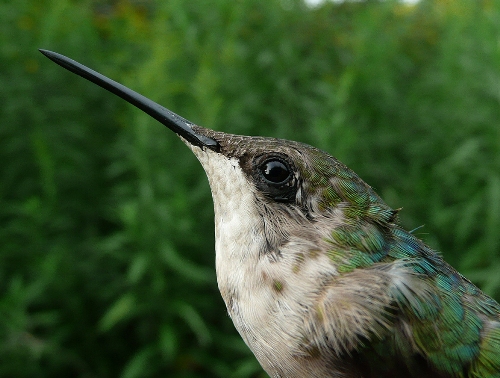
Ruby-throated Hummingbirds are one of the August specialties at MBO. Although we do not have the specialized permits or equipment to band them, we still catch some, and try to at least note their age and sex for our records.
(Photo by
Gay Gruner) |
We know better than to make predictions about a season based on just the first week, but certainly the record number of first-week birds banded this year is a promising sign. We have another 12 weeks of fall migration monitoring ahead, and as always will be able to complete the season successfully only with countless hours of volunteer help. Please check out our volunteer section if you would like to help out, and keep checking the website for our weekly reports from now through to the end of October.
|
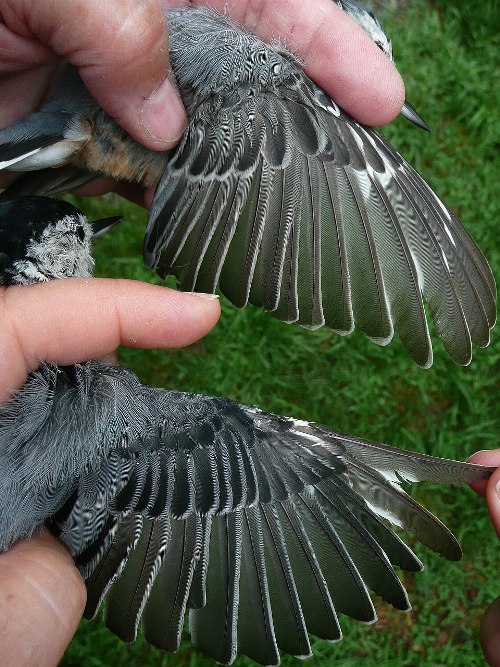
Although permanent residents at MBO, White-breasted Nuthatches are awfully good at avoiding the nets, with on average less than one banded each year. In fact, never before have we banded more than one in an entire season, so catching two at the same time was quite a surprise! Above, a hatch-year female; below, a second-year male (very likely her father), completing his prebasic moult.
(Photo by
Gay Gruner)
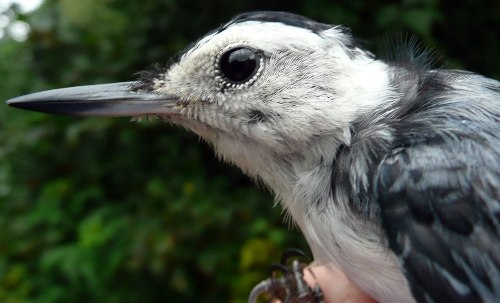
Profiles of the male (above) and female (below), showing the difference in plumage between the sexes.
(Photos by
Gay Gruner)
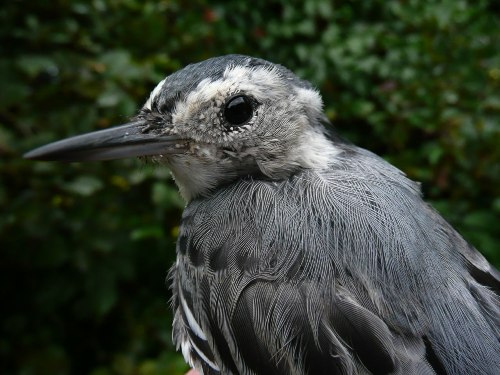
|






